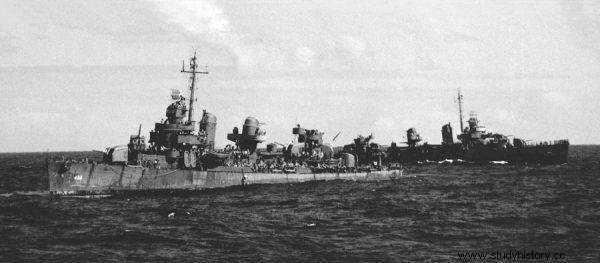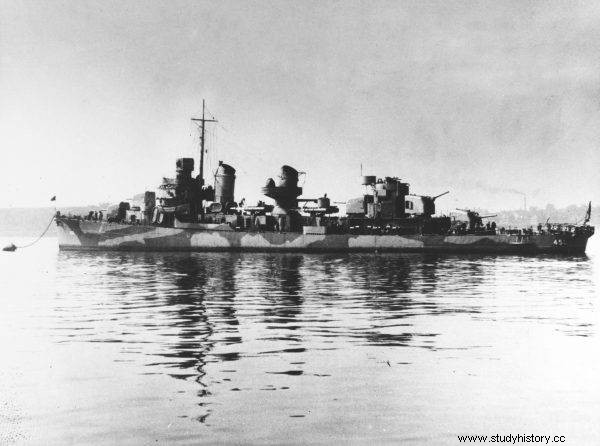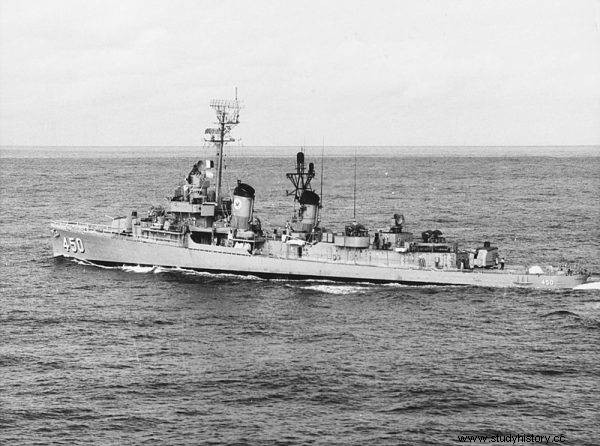Many amazing stories happened during World War II. However, it would be hard to suppose that one of them could be attacking an enemy submarine with ... potatoes. Not only did it happen, it also brought the expected results!
USS O'Bannon (DD-450) was an American Fletcher-class destroyer. During the two years of the war, 175 units of this class were built. They had a displacement of 2050 GRT and - which was their strong point - they could reach speeds of up to 35 knots. The unit was launched on February 19, 1942, and commissioned on June 26. The commander of the destroyer was Lieutenant Commander Edwin R. Wilkinson. It was the second US Navy ship to be named after that - in honor of the hero of the First Berber War, Captain Presley O'Bannon.
After the necessary exercises in the Caribbean area, on August 29, the destroyer was directed to the Pacific, where the Battle of Guadalcanal had just begun. O'Bannon ended up in New Caledonia and was drafted into the 21st Destroyer Squadron. His first assignment was to cover the escort carrier USS Copahee, which was sailing as support to Guadalcanal.
During the fierce fighting, the Japanese lost a very valuable airport in the Solomon Islands, which they called Runga. After the Americans took it over, it was renamed Henderson Airport. When attempts to recapture the airport were unsuccessful, the Japanese decided to destroy it as it was too important support for American operations in the South Pacific.
First match
On November 7, O'Bannon was inducted into the Admiral Daniel J. Callaghan Support Group. The team covered a convoy transporting infantry, food, ammunition and aircraft materials. During this voyage, O'Bannon noticed a submarine surfaced and immediately opened fire on it. Although he failed to sink his enemy, kept him under water until the convoy sailed off to a safe distance .
On November 12, the convoy was attacked by 15 torpedo bombers. A strong firewall caused all but one of the planes to be shot down. O'Bannon contributed to the destruction of four of them.

On November 7, O'Bannon was inducted into the Admiral Daniel J. Callaghan Support Group.
The Japanese did not give up. A team of two battleships, a light cruiser, and 14 destroyers set out to stop the convoy and prevent valuable materials and infantry support from strengthening the U.S. military. The Yankees had the Support Group that O'Bannon belonged to, along with two heavy and three light cruisers, and eight destroyers.
The skirmish took place in the early morning of November 13. O'Bannon focused on the Japanese battleship Hiei. He got so close to it that the Japanese gun crew could not launch their attack, for she was unable to lower the barrels of her guns low enough. Their volleys flew overhead to the Americans.
O'Bannon and the rest of his group's ships shelled the battleship and severely damaged it. The wounded colossus became an easy target and was sunk by planes from the carrier USS Enterprise the next day. Overall, the Americans lost two light cruisers - one of them killed Admiral Callaghan, and four destroyers. In addition to the battleship, the Japanese lost two destroyers. Most importantly, however, they withdrew from the battlefield. The materials reached their destination and Henderson's airport was saved. The very next day, planes taking off from it managed to sink 11 Japanese army transporters.
Potatoes… PAL!
RO-34 was a Japanese Kaichū VI type submarine. It was a medium-sized unit equipped with both an anti-aircraft gun and an anti-aircraft machine gun. On the evening of April 5, 1943, when RO-34 was afloat, it was spotted by watchmen from the deck of O'Bannon.
Initially, the American commander wanted to ram the enemy. The order was canceled shortly before the potential impact, as it was feared that the ship might be a submarine minelayer. Ramming could therefore prove fatal for the Americans as well. In the last second, we managed to maneuver the ship to avoid a collision. The destroyer was on the right side of the submarine. There was a repeat of the story with battleship Hiei, but this time the Americans were unable to lower their guns enough to successfully attack the enemy.

Literally in the last second, we managed to maneuver the ship so as not to allow a collision. The destroyer is on the starboard side of the submarine.
The Japanese, initially shocked by the close presence of an American destroyer, quickly recovered and began manning the deck guns. They were in a perfect position to attack the Americans who turned from hunters to game in an instant. It was immediately necessary to come up with something that would allow them to buy some necessary time to go far enough to start firing. There was only a bucket in sight that someone had left on deck. And inside… potatoes. Without a second thought, the soldiers used them during the attack.
The potatoes thrown onto the deck of a Japanese submarine resembled hand grenades. They also made a metallic noise, hitting the ship's hull. The surprised Japanese thought that there would be a series of explosions soon! Instead of manning the cannon, they proceeded to discard the "charges" from the deck, unaware of what they were dealing with. Falling dusk additionally helped the Americans to hide their trick.
The potato attack proved successful and provided the time needed to swim far enough away from the enemy and proceed with the real attack. Even before the RO-34 could submerge, it received hits from the on-board gun and was then finished off with a series of depth charges. For their amazing feat, the crew received a special commemorative plaque, funded by potato growers in Maine.
True or false?
The story of a destroyer crew using potatoes to sink an enemy submarine was quickly picked up by the press. The catchy tale won the hearts of the readers. However, there are also those who question its authenticity . The first argument is that the commander, Donald John MacDonald, who commanded the destroyer in 1943, did not comment on this. In addition, there is no mention of an attack by potatoes in the logbook. It only recorded that as soon as O'Bannon reached the appropriate distance from the enemy, he opened fire with 20 and 40 mm cannons, then turned and attacked the submerged ship with a series of depth charges.
On the other hand, it is hardly surprising that there is no entry on this in the logbook, as they usually only give facts and not sensational descriptions.

USS O’Bannon
In addition, the commander did not remember the attack with potatoes even taking place. In his opinion, at most, a shipworm who happened to be on board could throw a potato towards the enemy, but he would have to have an extremely efficient hand not only to throw in such a distance, but also to hit ...
Today it is difficult to say unequivocally what is true and what is just a legend. The commander could be silent so as not to expose himself and his crew to a laughing stock among the sailors' brothers. Anyway, events happened so quickly that MacDonald probably couldn't grasp everything that happened around him. The fact is that the Japanese ship was sunk, and the legend of the crew that used potatoes to sink it survived and is alive to this day ...
